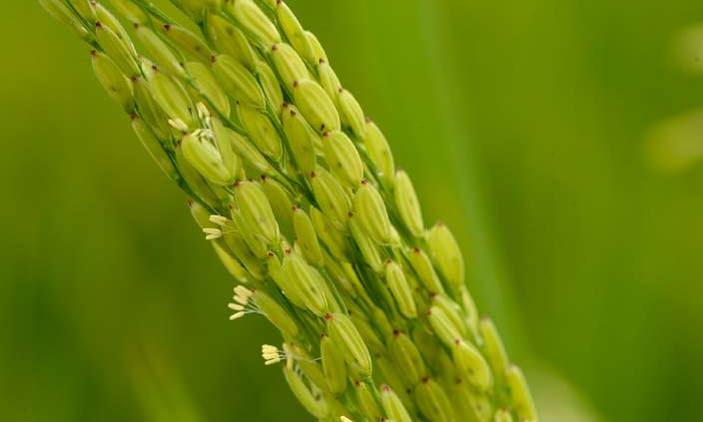
Joint BioEnergy Institute Study Identifies Bacterial Protein that is Key to Protecting Rice against Bacterial Blight
A bacterial signal that when recognized by rice plants enables the plants to resist a devastating blight disease has been identified by a multi-national team of researchers led by scientists with the U.S. Department of Energy (DOE)’s Joint BioEnergy Institute (JBEI) and the University of California (UC) Davis.
The research team discovered that a tyrosine-sulfated bacterial protein called “RaxX,” activates the rice immune receptor protein called “XA21.” This activation triggers an immune response against Xanthomonas oryzaepv.oryzae (Xoo), a pathogen that causes bacterial blight, a serious disease of rice crops.
“Our results show that RaxX, a small, previously undescribed bacterial protein, is required for activation of XA21-mediated immunity to Xoo,” says Pamela Ronald, a plant geneticist for both JBEI and UC Davis who led this study. “XA21 can detect RaxX and quickly mobilize its defenses to mount a potent immune response against Xoo. Rice plants that do not carry the XA21 immune receptor or other related immune receptors are virtually defenseless against bacterial blight.”
Ronald, who directs JBEI’s grass genetics program and is a professor in the UC Davis Department of Plant Pathology, is one of two corresponding authors of a paper describing this research inScience Advances, along with Benjamin Schwessinger, a grass geneticist with JBEI’s Feedstocks Division at the time of this study and now with the Australian National University. The paper is titled “The rice immune receptor XA21 recognizes a tyrosine-sulfated protein from a Gram-negative bacterium.” (See end of story for a complete list of authors.)
Rice is a staple food for half the world’s population and a model plant for perennial grasses, such as Miscanthus and switchgrass, which are prime feedstock candidates for the production of clean, green and renewable cellulosic biofuels. Just as bacterial blight poses a major threat to rice crops, bacterial infections of grass-type fuel plants could present major problems for the future production of advanced biofuels. However, the mechanisms by which bacteria infect such grasses is poorly understood.
“Pathogens of grass-type biofuel crops that would reduce the yield of fuel-producing biomass likely use similar infection mechanisms to Xoo,” says Schwessinger. “Having identified the activator of XA21, we will be able to study the rice immune system in far greater detail than ever before. As rice is the model for grass-type biofuel feedstocks, this might help in the future engineering of more disease-resistant grass-type biofuel crops.”
Most plants and many animals can only defend themselves against a given disease if they carry specialized immune receptors that sense the invading pathogen behind the disease. In 2009, Ronald and her group identified a small bacterial protein they named “Ax21” as the molecular key that binds to the XA21 receptor to activate a rice plant’s immune response. Diligent follow-up research by her group led to Ronald retracting these results and continuing the search for the true key.
“We were ecstatic with our results in 2009 because identifying the molecule that XA21 recognizes provides an important piece to the puzzle of how the rice plant is able to respond to infection,” Ronald says, “but then it was back to the drawing board. Now we have the real XA21 activator.”
Read more: Unlocking the Rice Immune System
The Latest on: Rice Immune System
[google_news title=”” keyword=”Rice Immune System” num_posts=”10″ blurb_length=”0″ show_thumb=”left”]
via Google News
The Latest on: Rice Immune System
- Best dog food for sensitive stomachs, according to expertson April 26, 2024 at 10:46 am
We interviewed experts, who explained that the best dog foods for sensitive stomachs all feature easy-to-digest formulas in a range of flavors and food types.
- These Are the 20 Healthiest Vegetables Of All Time, According to Registered Dietitianson April 26, 2024 at 7:34 am
All vegetables are not created equal, so get more bang for your bite with our list of expert-approved healthy vegetables.
- Does replacing rice with corn help lose weight?on April 26, 2024 at 4:07 am
Concerned about the high starch content in rice, I consume three to four ears of corn daily to aid in weight loss. Is this method effective? (Luong, 22, Hanoi) ...
- The healthiest beans and legumes, according to dietitianson April 25, 2024 at 11:56 am
Beans and legumes are a nutrient-rich, affordable and delicious source of protein. Dietitians discuss the health benefits of beans and the healthiest ones.
- Sauerkraut has plenty to offer, from tangy flavor to some health benefitson April 24, 2024 at 3:30 am
Although sauerkraut is perhaps the best-known national dish of Germany, and has been a staple of the German diet since the 1600s, it didn’t originate in Germany.
- I’m a fitness coach — here are the 3 foods I eat every dayon April 23, 2024 at 6:16 pm
One thing about me is I like to eat, so having these foods on deck keeps me satiated throughout the day, and [they are] also keeping me in pretty good shape,” Jenna Rizzo shared.
- Reprogramming the immune system to attack cancer cellson April 22, 2024 at 11:31 am
Researchers at Virginia Tech's developed a new therapy to target cancer with localized cytokine treatment to boost the immune system.
- 12 Rice Additions You Probably Never Thought Ofon April 20, 2024 at 10:26 am
In many households, rice is always in the pantry because it's inexpensive and easy to make; you don't need any special cooking skills. It's easy to take a bag of rice and put a meal together, whether ...
- Can Your Immune System Be Rejuvenated? Yes, Says New Researchon April 19, 2024 at 11:01 am
As we age, the immune system begins to weaken. This leaves us exposed to dangerous infections. But a new study offers hope: we may soon be able to reverse the trend.
- How climate change is driving a global epidemic of immune health problems, and how to stop iton April 4, 2024 at 10:28 am
Every $1 spent on mitigating climate change would save at least $3 in health care costs, largely through a reduction of diseases such as asthma and allergies.
via Bing News











